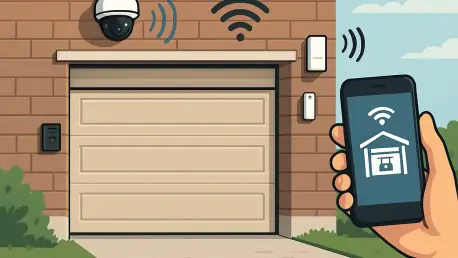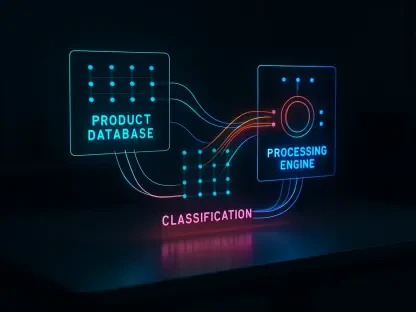In an era where smart homes are becoming increasingly interconnected, the security of every entry point must be scrutinized with a cyber-physical lens, and one often-overlooked vulnerability lies in the garage door—a massive, moving barrier that serves as both a physical and digital access point. Many homeowners fail to recognize this critical perimeter as part of their network, yet modern garage door openers are equipped with Wi-Fi, Bluetooth, and cloud integrations, making them potential targets for cyber threats. Beyond digital risks, the sheer mechanical force of a garage door, weighing hundreds of pounds, poses significant safety hazards if not properly maintained. Addressing these dual challenges transforms a simple household fixture into a fortified asset. By treating the garage door as an IT component and applying rigorous security and maintenance protocols, households can significantly enhance overall smart home protection, closing gaps that attackers might exploit.
1. Recognizing the Garage Door as a Network Asset
The integration of garage doors into smart home ecosystems has shifted their role from mere mechanical devices to connected assets that demand cybersecurity attention. Modern openers communicate via wireless protocols and often store data on vendor platforms, creating new attack vectors for malicious actors. Homeowners must adopt a mindset that views these doors as part of the broader network infrastructure, similar to laptops or security cameras. This perspective changes how threats are assessed, moving beyond physical break-ins to include remote hacking risks. Applying IT discipline to these devices means rethinking access controls, update schedules, and even daily usage patterns to ensure they don’t become weak links in the security chain. Without this shift, the largest moving part of a home remains an unmonitored backdoor, vulnerable to both digital intrusion and mechanical failure that could compromise safety.
Elevating the garage door to the status of a critical IT asset also impacts maintenance and investment decisions for long-term security. A comprehensive threat model must account for unauthorized remote access, outdated firmware, and even social engineering tactics targeting temporary access codes. Regular audits of connected features should be as routine as checking locks on windows and doors. Budgeting for upgrades that prioritize encryption and network isolation becomes a priority over merely aesthetic improvements. This approach not only mitigates risks but also maximizes the return on security spending by preventing costly breaches or repairs. As smart homes grow more complex, integrating garage door security into the broader strategy ensures that no entry point is left unprotected, reinforcing the entire perimeter against evolving threats.
2. Securing the Digital Interface of Garage Doors
Modern garage door openers are no longer standalone mechanisms; their Wi-Fi and Bluetooth capabilities connect them directly to home networks, exposing them to the same risks as other IoT devices. This connectivity, while convenient, means that they can be hacked if not properly secured, potentially granting attackers access to the home. To mitigate this, it’s essential to segment the opener on a dedicated SSID or VLAN, separating it from more sensitive devices like personal computers. Disabling unused legacy radios and enforcing strong, unique local credentials further reduces exposure. Enabling automatic firmware updates ensures that vulnerabilities are patched promptly, maintaining the device’s resilience against known exploits and keeping it aligned with current security standards.
Beyond basic segmentation, enhancing network security involves activating client isolation features on routers when available, ensuring that a compromised IoT device cannot pivot to other endpoints. This layered approach minimizes the blast radius of a potential breach, protecting critical systems from lateral attacks. Additionally, monitoring network traffic for unusual activity related to the garage door opener can provide early warnings of tampering or unauthorized access attempts. Homeowners should also consider disabling remote access features if they are not regularly used, as these often serve as entry points for attackers. By treating the garage door’s digital interface with the same rigor as other connected devices, the risk of cyber intrusions through this often-ignored perimeter can be significantly diminished.
3. Strengthening Wireless Security and Encryption
Older garage door remotes, reliant on fixed codes, are alarmingly easy for attackers to intercept and replay using basic software-defined radios, granting unauthorized access with minimal effort. Upgrading to openers that utilize rolling-code authentication is a critical step, as this technology changes the credential with each use, rendering intercepted signals useless. When selecting a new system, compatibility with modern encryption standards must be confirmed to safeguard data transmission. Features like app-based two-factor authentication add an extra layer of protection, while revocable digital keys offer secure temporary access for guests or delivery services, ensuring control over who enters and when without compromising long-term security.
Managing shared access devices is equally important in maintaining a secure wireless environment for garage doors. Shared remotes should be treated like outdated access cards, with regular rotation and decommissioning to prevent misuse by former users or lost devices. Ensuring that all users are aware of security protocols, such as not sharing codes or remotes, reinforces the system’s integrity. Additionally, checking for firmware updates specific to wireless components can address vulnerabilities in communication protocols. By prioritizing these advanced security measures, the wireless interface of garage doors becomes a fortified barrier rather than a potential entry point for cyber threats, aligning with broader smart home protection goals.
4. Balancing Physical Safety with Digital Security
While cyber threats to garage doors are a growing concern, the physical risks associated with these heavy, fast-moving barriers cannot be ignored, as they pose significant safety hazards if not maintained properly. Weighing hundreds of pounds, a malfunctioning door or failing torsion springs can cause serious injury or property damage. Scheduling quarterly safety inspections alongside digital patch updates ensures that mechanical risks are addressed systematically. These checks should include testing the auto-reverse function with a simple wood block to confirm it stops and reverses upon contact, a critical feature for preventing accidents. Aligning photo eyes and verifying that the emergency release holds the door at mid-height to indicate balanced springs are also essential tasks.
Documenting these physical safety checks with the same diligence as digital security logs creates a comprehensive maintenance record that highlights trends and potential issues before they escalate. Cleaning and aligning photo eyes regularly prevents false readings that could disable safety mechanisms. Listening for unusual noises during operation can signal early wear in components like rollers or tracks, prompting timely intervention. Combining these physical inspections with cyber hygiene practices ensures that neither aspect of garage door security is overlooked. This dual focus reduces the likelihood of both mechanical failures and digital breaches, creating a safer and more secure home environment where all risks are proactively managed.
5. Leveraging Operational Data for Proactive Maintenance
Modern garage door openers come equipped with telemetry features that track operational metrics such as cycle counts, load spikes, and temperature variations, offering valuable insights into the system’s health. Feeding this data into a simple dashboard or even a spreadsheet allows for real-time monitoring and analysis of performance trends. Rising motor torque, for instance, may indicate roller wear, bearing friction, or track misalignment—issues that, if unaddressed, could lead to failures that compromise security or strand vehicles. Recognizing these anomalies as actionable alerts enables scheduling of planned service calls, preventing unexpected breakdowns and maintaining the door’s reliability as a secure entry point within the smart home ecosystem.
Prioritizing predictive maintenance over reactive emergency repairs aligns with a reliability engineering mindset that saves costs and enhances security. By addressing potential problems before they manifest, such as lubricating components or adjusting tension based on data trends, the risk of a door being stuck open or closed due to mechanical failure is minimized. This approach also extends the lifespan of the garage door system, reducing the need for frequent replacements. Regularly reviewing telemetry data alongside physical inspections creates a holistic maintenance strategy. Such proactive care ensures that the garage door remains a dependable part of the home’s security infrastructure, safeguarding against both operational disruptions and potential vulnerabilities.
6. Enhancing Environmental Control at Entry Points
The garage serves as a buffer zone between the outdoors and living spaces, and installing insulated doors with tight perimeter seals can significantly stabilize internal temperatures, offering multiple security benefits. By maintaining a consistent environment, the strain on HVAC systems in adjacent rooms is reduced, lowering energy costs and minimizing wear on climate control equipment. This stability is particularly important in regions with extreme weather, where temperature swings can impact both comfort and utility expenses. A well-sealed garage door not only contributes to energy efficiency but also supports a more controlled space that indirectly bolsters the home’s overall security by reducing environmental stressors on connected systems and stored items.
Moreover, a stable garage environment protects equipment and tools stored within from humidity fluctuations that can lead to corrosion of circuits and metal parts, preserving their functionality and longevity. A comfortable workspace also discourages the common practice of propping doors open during projects or repairs, which creates an opportunistic entry path for intruders. Ensuring that the garage remains a secure, enclosed area reduces the temptation to compromise security for convenience. By focusing on environmental control through proper insulation and sealing, the garage door becomes a more robust barrier, contributing to both physical security and the protection of valuable assets housed within the space.
7. Establishing Access Policies and Activity Tracking
Treating a garage door like an enterprise-grade access system transforms its role in smart home security by enforcing strict control over who enters and when. Assigning named users to the system, where possible, and logging all openings provides a clear audit trail for accountability. This approach mirrors corporate badge reader protocols, ensuring that every activation is traceable to a specific individual. Setting geofenced auto-close schedules adds another layer of protection, automatically shutting the door if it’s left open after a vehicle departs, addressing the common issue of distraction. Such automation minimizes human error, maintaining a secure perimeter even during busy or forgetful moments.
Managing temporary access is equally critical, especially for contractors or delivery personnel who require short-term entry. Issuing digital keys that can be revoked immediately after use prevents lingering vulnerabilities from unused credentials. If the opener supports camera snapshots upon activation, storing these clips securely with limited retention periods ensures visual records without unnecessary data accumulation. Regularly reviewing access logs for unusual patterns, such as unexpected openings at odd hours, can also flag potential security issues early. By implementing these structured policies and tracking mechanisms, the garage door evolves into a controlled access point that aligns with comprehensive smart home security strategies.
8. Choosing Reliable Service Providers for Installation
Selecting a service provider for garage door installation or repair goes beyond comparing costs; it requires evaluating technical expertise and commitment to security. Providers should be questioned on how they size springs to match usage demands, whether they install vibration isolators to minimize structural noise, and how they configure firmware during handover to ensure digital safety. These details reflect a provider’s understanding of both mechanical reliability and cyber protection. A reputable technician will prioritize secure setups that prevent unauthorized access through default settings or outdated software, integrating the door seamlessly into the smart home network without introducing new risks.
Verification of professional standards is also essential when choosing a service partner. Confirming insurance coverage, training credentials, and the provision of written safety and balance reports ensures accountability and quality. Requesting force test results and a quick tutorial on mechanical checks and app settings empowers homeowners to maintain security independently. Good documentation from the provider serves as a reference for future maintenance and troubleshooting. By partnering with a skilled and transparent service team, the garage door’s installation and ongoing care become integral to a fortified smart home, blending physical durability with digital safeguards.
9. Building a Future of Reinforced Home Protection
Reflecting on the journey of integrating garage doors into smart home security, it becomes evident that a dual focus on cyber and physical measures has transformed a common entry point into a robust line of defense. The adoption of network segmentation, modern encryption, and regular safety checks has closed critical vulnerabilities that once lingered unnoticed. Moving forward, homeowners should commit to routine maintenance schedules that balance mechanical inspections with digital updates, ensuring no aspect is neglected. Exploring advanced telemetry tools to predict failures before they occur can further enhance reliability. Collaborating with local experts who understand regional challenges guarantees tailored solutions that withstand environmental wear. By embedding these practices into daily routines, the garage door stands as a testament to comprehensive security, protecting both the home and its connected future with unwavering strength.









